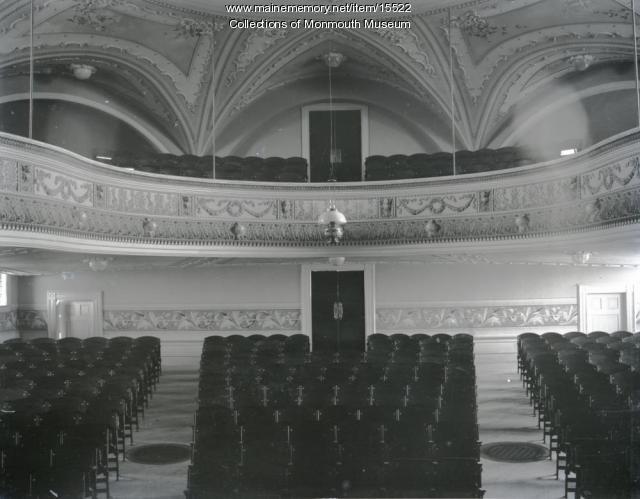Keywords: French
- Historical Items (731)
- Tax Records (18)
- Architecture & Landscape (4)
- Online Exhibits (96)
- Site Pages (152)
- My Maine Stories (66)
- Lesson Plans (2)
Online Exhibits
Your results include these online exhibits. You also can view all of the site's exhibits, view a timeline of selected events in Maine History, and learn how to create your own exhibit. See featured exhibits or create your own exhibit
Exhibit
"Music Makers Music Makers instruments Click to see more Music Makers Music makers in Maine make instruments, create music in their…"
Exhibit
Music in Maine - Music and Television
"Music and Television The Dave Astor Show Click to see more Dave Astor Show photos Dave Astor (1919-2011) produced a variety show in Portland…"
Exhibit
"Sacred Music People play and sing sacred music during religious services and events. Singing allows worshipers to participate in the liturgy, with…"
Exhibit
Music in Maine - Music Education
"Music Education Children's Music Click to see more Children's Music Child development educators agree music ignites the skills children need…"
Exhibit
Music in Maine - Opera, Orchestras and Stages
"Opera, Orchestras and Stages Click to learn more about Maine's Opera Houses Many Maine towns in the 19th and early 20th centuries had an…"
Exhibit
"PLAY Watching musicians sing and play music in public is an important communal experience for the performer and the audience."
Exhibit
Music in Maine - Bluegrass Music
"Bluegrass Music BLUEGRASS MUSIC ASSOCIATION OF MAINE Click to learn more about BMAM Bluegrass music—acoustic music played on banjo, mandolin…"
Exhibit
"Music stores Mary Curran Leighton and musicians, Portland, ca. 1930Maine Historical Society Hiram Chase & Son, Belfast, ca. 1895, ca."
Exhibit
Music in Maine - B-flat fife, ca. 1860
"B-flat fife, ca. 1860 Contributed by Maine Historical Society Description This fife was used by John Robbins when he was a drummer in the…"
Exhibit
Music in Maine - Drumsticks, 1861
"Drumsticks, 1861 Contributed by Maine Historical Society Description Franklin C. Kimball (1844-1912) used these drumsticks while serving…"
Exhibit
Music in Maine - Drum, Portland, ca. 1854
"Drum, Portland, ca. 1854 Contributed by Maine Historical Society Description Noble and Cooley of East Granville, Massachusetts started…"
Exhibit
Music in Maine - Civil War drum, ca. 1861
"Civil War drum, ca. 1861 Contributed by Maine Historical Society Description Henry Green (1832-1901) of Portland carried this military…"
Exhibit
Music in Maine - Drum, Stockton Springs, ca. 1840
"Drum, Stockton Springs, ca. 1840 Contributed by Maine Historical Society Description Colonel Freeman McGilvery (1823-1864) of Stockton…"
Exhibit
Music in Maine - Kimball Drum, ca. 1860
"Kimball Drum, ca. 1860 Contributed by Maine Historical Society Description Written on the top of the head of this drum is, "Frank C."
Exhibit
The Waldo-Hancock Bridge is in the process of being dismantled after over 70 years of service. The Maine State Archives has a number of records related to the history of this famous bridge that are presented in this exhibition.
Exhibit
Throughout New England, barns attached to houses are fairly common. Why were the buildings connected? What did farmers or families gain by doing this? The phenomenon was captured in the words of a children's song, "Big house, little house, back house, barn," (Thomas C. Hubka <em>Big House, Little House, Back House, Barn, the Connected Farm Buildings of New England,</em> University Press of New England, 1984.)
Exhibit
When Europeans arrived in North America and disrupted traditional Native American patterns of life, they also offered other opportunities: trade goods for furs. The fur trade had mixed results for the Wabanaki.
Exhibit
The Barns of the St. John River Valley: Maine's Crowning Jewels
Maine's St. John River Valley boasts a unique architectural landscape. A number of historical factors led to the proliferation of a local architectural style, the Madawaska twin barn, as well as a number of building techniques rarely seen elsewhere. Today, these are in danger of being lost to time.
Exhibit
In Maine, like many other states, a newly formed Ku Klux Klan organization began recruiting members in the years just before the United States entered World War I. A message of patriotism and cautions about immigrants and non-Protestants drew many thousands of members into the secret organization in the early 1920s. By the end of the decade, the group was largely gone from Maine.
Exhibit
Northern Threads: Early Republic era Fashion dolls
A themed exhibit vignette within "Northern Threads Part I," featuring Early Repulic-era (ca.1780-1820) fashion dolls.
Exhibit
Northern Threads: Civil War-era clothing
An exhibit vignette within "Northern Threads, Part 1," featuring American Civil War civilian and military clothing, 1860 to 1869.
Exhibit
Valentines Day cards have long been a way to express feelings of romance or love for family or friends. These early Valentines Day cards suggest the ways in which the expression of those sentiments has changed over time.
Exhibit
Rum, Riot, and Reform - 1919 to 1934: The Nation Follows Maine Into Prohibition
"… was smuggled from Quebec, St Pierre and Miquelon (French Islands off Newfoundland). For Maine and Massachusetts residents, buying a bottle was as…"
Exhibit
Westbrook Seminary: Educating Women
Westbrook Seminary, built on Stevens Plain in 1831, was founded to educate young men and young women. Seminaries traditionally were a form of advanced secondary education. Westbrook Seminary served an important function in admitting women students, for whom education was less available in the early and mid nineteenth century.
























